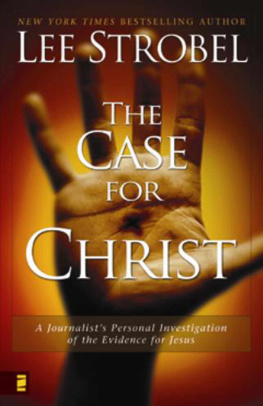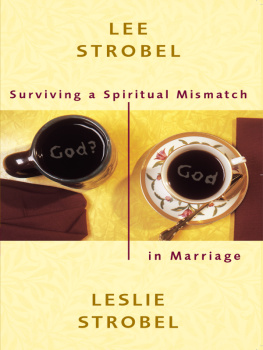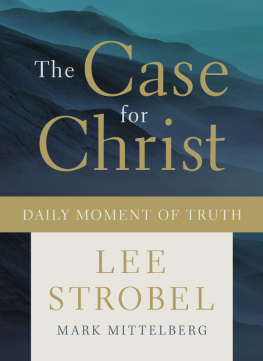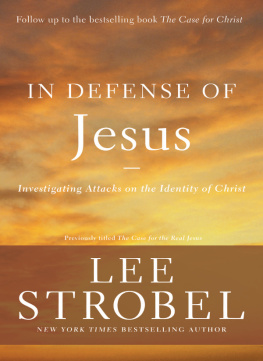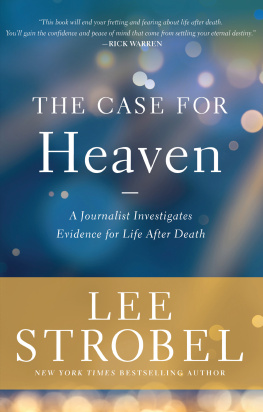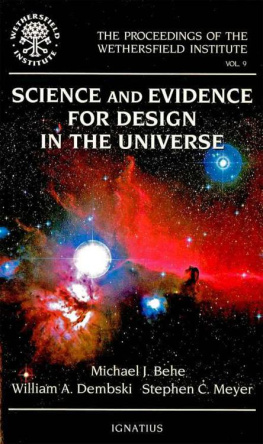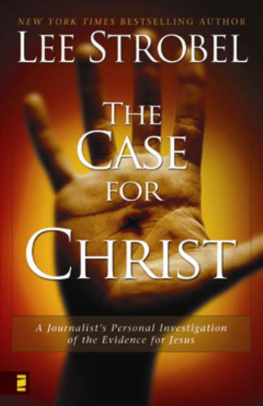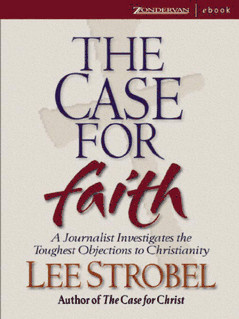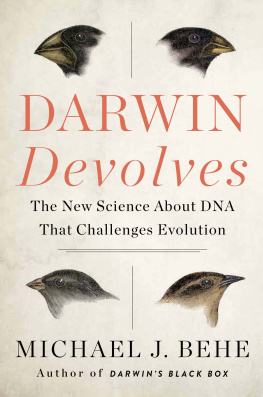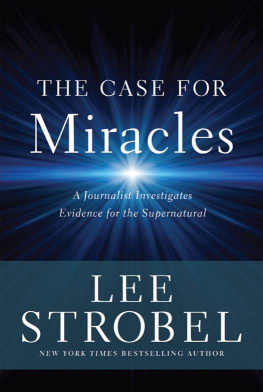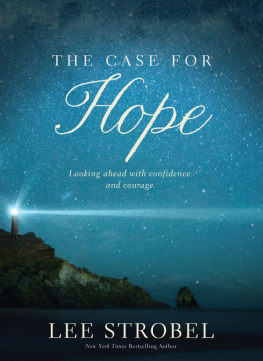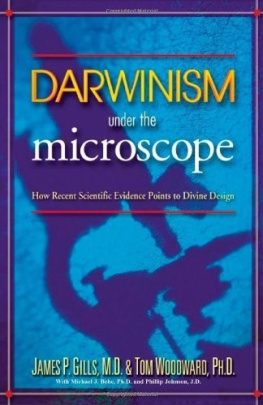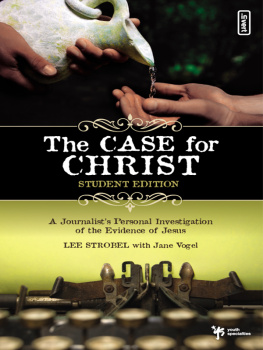I am extremely thankful for the insights and contributions that a variety of people have made to this book. In particular, Im indebted to Bill Hybels, who allowed me to produce a series of presentations on this topic at Willow Creek Community Church; my wife, Leslie, who came up with the idea of translating that concept into a book; and my editor, John Sloan, whose creative input greatly enhanced the project.
Also, Im grateful to Mark Mittelberg and Garry Poole for their ongoing encouragement and assistance; Chad Meister and Bob and Gretchen Passantino for their research and ideas; Russ Robinson for his legal perspective; my assistant Jodi Walle for her invaluable help; and my daughter, Alison, and son, Kyle, for their behind-the-scenes contributions.
Finally, Id like to thank the scholars who allowed me to interview them for this book. Again and again I was impressed not only by their knowledge and wisdom but also by their humble and sincere faithas well as their desire to help spiritual seekers investigate the outrageous claims of Jesus.
I n the parlance of prosecutors, the attempted murder case against James Dixon was
a dead-bang winner. Open and shut. Even a cursory examination of the evidence was enough to establish that Dixon shot police sergeant Richard Scanlon in the abdomen during a scuffle on Chicagos south side.
Piece by piece, item by item, witness by witness, the evidence tightened a noose around Dixons neck. There were fingerprints and a weapon, eyewitnesses and a motive, a wounded cop and a defendant with a history of violence. Now the criminal justice system was poised to trip the trap door that would leave Dixon dangling by the weight of his own guilt.
The facts were simple. Sergeant Scanlon had rushed to West 108th Place after a neighbor called police to report a man with a gun. Scanlon arrived to find Dixon noisily arguing with his girlfriend through the front door of her house. Her father emerged when he saw Scanlon, figuring it was safe to come outside.
Suddenly a fight broke out between Dixon and the father. The sergeant quickly intervened in an attempt to break it up. A shot rang out; Scanlon staggered away, wounded in his midsection. Just then two other squad cars arrived, screeching to a halt, and officers ran over to restrain Dixon.
A .22-caliber gun belonging to Dixoncovered with his fingerprints and with one bullet having been firedwas found nearby, where he had apparently flung it after the shooting. The father had been unarmed; Scanlons revolver remained in his holster. Powder burns on Scanlons skin showed that he had been shot at extremely close range.
Fortunately, his wound wasnt life-threatening, although it was serious enough to earn him a medal for bravery, proudly pinned on his chest by the police superintendent himself. As for Dixon, when police ran his rap sheet, they found he had previously been convicted of shooting someone else. Apparently, he had a propensity for violence.
And there I sat almost a year later, taking notes in a nearly deserted Chicago courtroom while Dixon publicly admitted that, yes, he was guilty of shooting the fifteen-year police veteran. On top of all the other evidence, the confession clinched it. Criminal court judge Frank Machala ordered Dixon imprisoned, then rapped his gavel to signal that the case was closed. Justice had been served.
I slipped my notebook into the inside pocket of my sports coat and ambled downstairs toward the press room. At the most, I figured my editor would give me three paragraphs to tell the story in the next days Chicago Tribune . Certainly, thats all it deserved. This wasnt much of a tale.
Or so I thought.
THE WHISPER OF AN INFORMANT
I answered the phone in the pressroom and recognized the voice right awayit was an informant I had cultivated during the year I had been covering the criminal courts building. I could tell he had something hot for me, because the bigger the tip, the faster and softer he would talkand he was whispering a mile a minute.
Lee, do you know that Dixon case? he asked.
Yeah, sure, I replied. Covered it two days ago. Pretty routine.
Dont be so sure. The word is that a few weeks before the shooting, Sergeant Scanlon was at a party, showing off his pen gun.
His what?
A pen gun. Its a .22-caliber pistol thats made to look like a fountain pen. Theyre illegal for anyone to carry, including cops.
When I told him I didnt see the relevance of this, his voice got even more animated. Heres the thing: Dixon didnt shoot Scanlon. Scanlon was wounded when his own pen gun accidentally went off in his shirt pocket. He framed Dixon so he wouldnt get in trouble for carrying an unauthorized weapon. Dont you see? Dixon is innocent!
Impossible! I exclaimed.
Check out the evidence yourself, came his reply. See where it really points.
I hung up the phone and dashed up the stairs to the prosecutors office, pausing briefly to catch my breath before strolling inside. You know the Dixon case? I asked casually, not wanting to tip my hand too early. If you dont mind, Id like to go over the details once more.
Color drained from his face. Uh, I cant talk about it, he stammered. No comment.
It turned out that my informant had already passed along his suspicions to the prosecutors office. Behind the scenes, a grand jury was being convened to reconsider the evidence. Amazingly, unexpectedly, the once airtight case against James Dixon was being reopened.
NEW FACTS FOR A NEW THEORY
At the same time, I started my own investigation, studying the crime scene, interviewing witnesses, talking with Dixon, and examining the physical evidence. As I thoroughly checked out the case, the strangest thing happened: all the new facts that I uncoveredand even the old evidence that had once pointed so convincingly toward Dixons guiltsnugly fit the pen gun theory.
- Witnesses said that before Scanlon arrived on the scene, Dixon had been pounding his gun on the door of his girlfriends house. The gun discharged in a downward direction; in the cement of the front porch there was a chip that was consistent with a bullets impact. This would account for the bullet that was missing from Dixons gun.
- Dixon said he didnt want to be caught with a gun, so he hid it in some grass across the street before police arrived. I found a witness who corroborated that. This explained why the gun had been found some distance from the shooting scene even though nobody had ever seen Dixon throw it.
- There were powder burns concentrated insidebut not abovethe left pocket of Scanlons shirt. The bullet hole was at the bottom of the pocket. Conclusion: a weapon had somehow discharged in the pockets interior.

